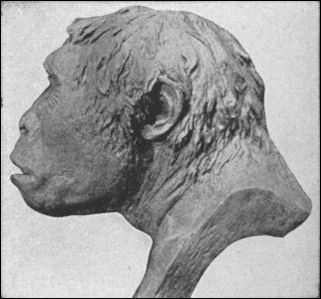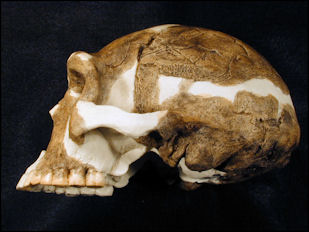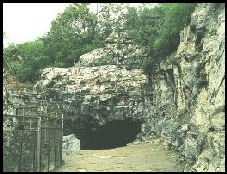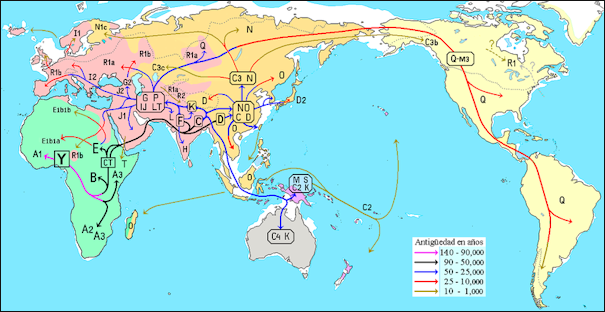FIRST HOMININS IN ASIA AND CHINA

Homo erectus in Asia
Hominins are early humans. Until recently scientists believed that man evolved in Africa and didn't leave that continent until 1.5 million years ago and the first hominin to arrive in Asia and Europe was homo erectus, a species which included the famous Java Man and Peking Man. Now scientists working in China and elsewhere in Asia are challenging these theories.
Homo erectus lived 1.7 million years to 250,000 years ago. He had a considerably larger brain than his predecessor Homo habilis, fashioned more advanced tools (double-edged, teardrop-shaped "hand axes" and "cleavers" ) and controlled fire (based on the discovery of charcoal with erectus fossils). Better foraging and hunting skills improved his ability to exploit his environment.
The discovery of 1.7-million-year-old hominin fossils in Georgia,1.8-million-year-old hominin fossils in Indonesia, and 1.9-million-year-old hominin fossils in China suggests that Homo erectus may have migrated into Asia as early as 2 million years ago and then migrated across the continent very quickly. There is also evidence that a hominin species more primitive than Homo erectus may have evolved in China before that time.
Websites and Resources on Hominins and Human Origins: Smithsonian Human Origins Program humanorigins.si.edu ; Institute of Human Origins iho.asu.edu ; Becoming Human University of Arizona site becominghuman.org ; Hall of Human Origins American Museum of Natural History amnh.org/exhibitions ; The Bradshaw Foundation bradshawfoundation.com ; Britannica Human Evolution britannica.com ; Human Evolution handprint.com ; University of California Museum of Anthropology ucmp.berkeley.edu; John Hawks' Anthropology Weblog johnhawks.net/ ; New Scientist: Human Evolution newscientist.com/article-topic/human-evolution
See Separate Articles: HOMO ERECTUS: BODY FEATURES, DEVELOPMENTS AND SKILLS factsanddetails.com ; HOMO ERECTUS SUBSPECIES, RELATED SPECIES AND FAMOUS FOSSILS factsanddetails.com ; HOMO ERECTUS AND OUT OF AFRICA THEORY factsanddetails.com ; DMANISI HOMININS —1.8-MILLION-YEAR-OLD HOMO ERECTUS IN GEORGIA factsanddetails.com ; HOMO ERECTUS AND THE FIRST HOMININS IN EUROPE factsanddetails.com
RECOMMENDED BOOKS:
“Ancestral DNA, Human Origins, and Migrations” by Rene J. Herrera (2018) Amazon.com;
“In search of Homo erectus: a Prehistoric Investigation: The humans who lived two million years before the Neanderthals” by Christopher Seddon (2017) Amazon.com;
“Asian Paleoanthropology: From Africa to China and Beyond” (Vertebrate Paleobiology and Paleoanthropology) by Christopher J. Norton and David R. Braun Amazon.com;
“Emergence and Diversity of Modern Human Behavior in Paleolithic Asia” by Yousuke Kaifu, Masami Izuho, et al. Amazon.com;
“Paleoanthropology and Paleolithic Archaeology in the People's Republic of China” by Wu Rukang, John W Olsen Amazon.com;
“Peking Man” Amazon.com;
“Java Man : How Two Geologists' Dramatic Discoveries Changed Our Understanding of the Evolutionary Path to Modern Humans” by Roger Lewin , Garniss H. Curtis, et al. Amazon.com;
“Processes in Human Evolution: The journey from early hominins to Neanderthals and modern humans” by Francisco J. Ayala, Camilo J. Cela-Conde Amazon.com;
“Evolution: The Human Story” by Alice Roberts (2018) Amazon.com;
“Perspectives on Our Evolution from World Experts” edited by Sergio Almécija (2023) Amazon.com;
“Discovering Us: Fifty Great Discoveries in Human Origins” By Evan Hadingham (2021) Amazon.com;
“Who We Are and How We Got Here: Ancient DNA and the New Science of the Human Past” by David Reich (2019) Amazon.com;
“Stone Tools in Human Evolution”
by John J. Shea (2016) Amazon.com;
“Our Human Story: Where We Come From and How We Evolved” By Louise Humphrey and Chris Stringer, (2018) Amazon.com;
“Lone Survivors: How We Came to Be the Only Humans on Earth” by Chris Stringer (2013) Amazon.com;
“Almost Human: The Astonishing Tale of Homo Naledi and the Discovery That Changed Our Human Story” by Lee Berger, John Hawks, et al. Amazon.com;
“An Introduction to Human Evolutionary Anatomy” by Leslie Aiello and Christopher Dean (1990) Amazon.com;
“Basics in Human Evolution” by Michael P Muehlenbein (Editor) (2015) Amazon.com;
“Sapiens: A Brief History of Humankind” by Yuval Noah Harari (2011) Amazon.com;
Java Man
Java man was discovered by Eugene DuBois, a young Dutch military doctor, who came to Java in 1887 with the sole purpose of finding the "missing link" between humans and apes after hearing about discoveries of ancient human bones (which later turned out to belong to modern man) near the Javanese village of Wajak, near Tulung Agung, in eastern Java.

Java Man With the help of 50 East Indian convict laborers, he discovered a skull cap and thighbone — that clearly didn't belong to an ape — along the banks of the Sunngai Bengawan Solo River in 1891. After measuring the cranial capacity of the skull with mustard seeds, Dubois realized that the creature was more of an "ape-like man" than a "man-like ape." Dubois dubbed the find “Pithecanthropus erectus”, or "upright ape-man,” which is now regarded as an example of “Homo erectus”.
The discovery of Java Man was the first major hominin find, and helped launch the study of early man. His finding created such a storm of controversy that Dubois felt compelled to re-bury the bones for 30 years to protect them.
DuBois was the student of Ernst Haeckel, a Charles Darwin disciple who wrote “History of Natural Creation” (1947), which advocated the Darwinian view of evolution and speculated about primitive human beings. Dubois came to Indonesia with the ambition of confirming Haekel’s theories. He died a bitter man because his discoveries he felt weren't taken seriously.
After Dubois other Homo erectus bones were unearthed in Java. In the 1930s, Ralph von Koenigswald found fossils, dated at be 1 million years old, near the village of Sangiran, along the Solo river, 15 kilometers north of Solo. Other fossils have been found along the Sungai Bengawan Solo in Central and East Java and near Pacitan in East Java’s south coast. In 1936 a skull of a child was found at Perning neat Mojokerto. Book: “Java Man” by Carl Swisher, Garniss Curtis and Roger Lewis.
See Separate Article JAVA MAN, HOMO ERECTUS AND PRE-HISTORIC INDONESIA factsanddetails.com
Homo Erectus in China
The dating of Java Man Homo erectus bones to around 1.5 million years ago suggests that Homo erectus traveled through China or nearby Southeast Asia to reach Java in Indonesia. Russell Ciochon and Roy Larick wrote in Natural History magazine, “There are a half dozen sites in China dating (more or less convincingly) to between 1.8 million and 800,000 years ago.” Some have stone tools. Others have human-like bones. There is some debate as to whether these bones belong to hominids or apes.
Paul Rincon of the BBC wrote: Comparisons with other sites show that Homo erectus survived successive warm and cold periods in northern Asia. Researchers Russell Ciochon and E Arthur Bettis III, from the University of Iowa, US, believe these climatic cycles may have caused the expansion of open habitats, such as grasslands and steppe. These environments would have been rich in mammals that could have been hunted or scavenged by early humans. [Source: Paul Rincon, BBC, March 11, 2009]
“Recent revised dates for other hominid occupation sites in North-East Asia show that human habitation of the region began about 1.3 million years ago.” Chinese “fossils are a vital component of the Out of Africa migration theory, which proposes that Homo erectus first appeared in Africa around two million years ago before spreading north and east (modern humans, Homo sapiens, would follow much later and supplant all other Homo species). Evidence of the first dispersal comes from the site of Dmanisi in Georgia, where numerous hominid fossils dating to 1.75 million years ago have been unearthed. Finds from Java suggest early humans reached South-East Asia by 1.6 million years ago. [Source: Paul Rincon, BBC, March 11, 2009 ^|^]
“The northern populations represented at Zhoukoudian [Peking Man, See Below] were probably separated from southern populations represented on the island of Java by a zone of sub-tropical forest inhabited by the giant panda, orangutans, gibbons and a giant ape called Gigantopithecus. It is not clear whether H. erectus ever reached Europe; the earliest European fossils have been assigned to the species Homo antecessor. But this classification is disputed, and some researchers believe the Spanish antecessor fossils do indeed belong with H. erectus. Recent discoveries suggest that on the Indonesian island of Flores, Homo erectus, or another early human species, became isolated and evolved into a dwarf species called Homo floresiensis, nicknamed "The Hobbit".” ^|^
See Separate Article PEKING MAN: FIRE, DISCOVERY AND DISAPPEARANCE factsanddetails.com ; EARLIEST HOMININS AND HUMAN ANCESTORS IN CHINA factsanddetails.com
Peking Man
 Peking Man (Sinanthropus pekinensis) was not a single individual, but a species of Homo erectus who were very similar to modern humans, having a large brain, and similar skull and bone sizes, but who had heavy brows and large, chinless jaws. They lived between 750,000 and 200,000 years ago.
Peking Man (Sinanthropus pekinensis) was not a single individual, but a species of Homo erectus who were very similar to modern humans, having a large brain, and similar skull and bone sizes, but who had heavy brows and large, chinless jaws. They lived between 750,000 and 200,000 years ago.
"Peking Man" refers to a collection of six complete or nearly complete skulls, 14 cranial fragments, six facial fragments, 15 jawbones, 157 teeth, one collarbone, three upper arms, one wrist, seven thighbones, and one shinbone found in caves and a quarry in Zhoukoudian outside of Peking (Beijing). It is believed the remains came from 40 individuals of both sexes. Both Peking Man and Java Man have been categorized as members of the hominid species Homo erectus.
The Peking Man bones are the largest collection of hominid bones ever found at one site and were the first evidence that early man reached China. It was first thought the bones were between 200,000 and 300,000 years old. Now it is believed that they are 400,000 to 780,000 years old based on dating the sediments in which the fossils were found. No chemical tests or research were ever done on the bones before they mysteriously disappeared at the beginning of World War II. Paul Rincon of the BBC wrote: “The cave system of Zhoukoudian, near Beijing, is one of the most important Palaeolithic sites in the world. Between 1921 and 1966, archaeologists working at the site unearthed tens of thousands of stone tools and hundreds of fragmentary remains from about 40 early humans. Palaeontologists later assigned these members of the human lineage to the species Homo erectus. The pre-war Peking Man fossils vanished in 1941 whilst being transported to the US for safekeeping. Luckily, the palaeontologist Franz Weidenreich had made casts for researchers to study.” [Source: Paul Rincon, BBC, March 11, 2009]
See Separate Article on PEKING MAN
Hominid Sites from China

Peking Man cave There are a lot of very old hominid sites in China and a lot of controversy surrounding them and the interpretations that have been drawn from them. The following is a sample of some of these. The dating and conclusions made from some of the sites are still being debated by paleontologists.
Stones tools found in Renzidong (Reni Cave) in Anhui Province in eastern China suggest that Homo erectus may have established itself in China 2.25 million years ago. Teeth and tools found in Chinese province of Yunnan once thought to be 700,000 year old were redated and found to be 1.8 millions year old through paleomagnetic analysis. Stone tools found in the Nihean Basin of north-central China indicate that humans lived in northern China as early as 1.36 million years ago.
A skull found in Yunxian, China, believed to be at least 600,000 years old, has browridges like Homo erectus specimens found in Java has the facial features that are more similar to younger skulls found in Europe. "This mix of characteristics tells us that there was more diversity within Homo erectus than we had thought," one scientist told National Geographic. Other scientist believe that skull is not from Homo erectus at all but from a species called Homo heidelbergensis that may have given birth to modern humans and Neanderthals.
Male and female Homo erectus skulls (sometimes referred to as Nanjing Man) were discovered in 1993 in Tangshan Cave near Shanghai. They have been dated to be between 580,000 to 620,000 years old.
Nihewan and Yuanmou Homo erectus Sites
According to the Smithsonian: “Since 2001, the Human Origins Program has collaborated with the Chinese Academy of Sciences to study the oldest clues to the spread of human ancestors to East Asia. This work has re-calculated the age of excavated discoveries by earlier teams, particularly in the extraordinary fossil beds of the Nihewan basin of northern China (Hebei Province) and the Yuanmou site in southern China (Yunnan Province). [Source: Human Origins Initiative, Smithsonian Institution, May 4, 2016 /]
“In both regions, our team has re-examined the early hominin evidence and has undertaken geological reanalysis of the excavation sites. The geological work entails micro-sampling of the sediments to determine the finest scale changes in the magnetic properties of the sediments, which can be tied to the sequence of well-dated shifts in Earth’s magnetic field. The last of the major shifts occurred around 790,000 to 780,000 years ago (known as the Brunhes-Matuyama boundary), and the detailed sampling by the Chinese team has even captured minor shifts in the magnetic field. /
“The Nihewan research includes new excavations, which have led so far to the recovery of the oldest known stone tools in northern China, in a series of layers dating from approximately 1.66 to 1.32 million years old. The Yuanmou stone tools and fossil incisor teeth are from a layer dated around 1.7 million years ago. These ages are based on the calculation of rates of sediment deposition between the known magnetic transitions in the Nihewan and Yuanmou strata. Ages can be determined because calculations of deposition rate in different parts of the sequence are all highly consistent; this implies that the age of the fossils and artifacts within the sediments can be reliably estimated.” /

Modern man (not Homo erectus) migrations based
on genetic evidence beginning 140,000 years ago
1.9-Million-Year-Old Hominin Fossils in China?
In the late 1980s, Chinese paleontologists working at Longgupo (Dragon Hill) caves on the Yangtze River in Sichuan province found part of a tiny, lower jaw with an upper incisor tooth, two other teeth and two fist-size stone tools dated by three techniques to be 1.8 to 2 million years old. The fossils resemble homo habilis, a hominin that first appeared in Africa 2.5 million years ago.
Some scientists believe the fossils come from an hominin older than homo erectus. Critics say they come from an ape. It is difficult to tell for sure without more remains. Stones tools link the bones to hominins.
The Longgupo cave fossils were dated using paleomagnetic dating — a method that dates objects by measuring the periodic reversals of the north and south magnetic poles, which have occurred at known times and rates — and the new method of electron spin resonance. The most reliable and accurate way to date very old fossils is to date the volcanic deposits they are found in. China however lacks volcanic deposits and thus fossils found there are more difficult to date than those found in Africa and Indonesia, where volcanic deposits are abundant.
University of Iowa paleontologist Russel Ciochon theorizes that a species similar to homo habilis left Africa two million years ago and moved into Asia, evolved into homo erectus, and returned to Africa. He told Newsweek magazine, if the dating holds up "these fossils will be older than any other human remains in China, and the tools will be the oldest artifacts in Asia." The fossils come from a hominin that "wasn't Homo habilis, and it wasn't Homo erectus, but some other pre-erectus species of Homo. Right before 2 million years ago Homo spread out of Africa." Many other paleontologists have problems with this theory.
See Separate Article HOMO ERECTUS AND THEORIES AND CONTROVERSIES ABOUT THE EARLIEST HOMINIDS IN CHINA factsanddetails.com
1.8-Million-Year-Old Hominin Fossils in Georgia

Is he Homo erectus or Homo georicus
The Dmanisi hominins refers to population of early hominins whose fossils were found at Dmanisi, Georgia. The fossils and stone tools found there range in age from 1.85 to 1.77 million years old, making them the earliest well-dated hominin fossils in Eurasia and the oldest undisputed hominin fossils found outside of Africa. The first of these fossils were unearthed in 1991 and big deal was made when the first skulls were unearthed in the late 1990s. Earlier fossils and artifacts have been found in Asia but they have not been as precisely dated and carefully excavated as the Dmanisi fossils Though the precise classification is still disputed, the Dmanisi fossils are highly significant for the insights they provide on early hominin migrations out of Africa. [Source: Wikipedia]
The Dmanisi fossils is the largest collection of “Homo erectus” bones ever found in one place and and the best preserved fossils of early Homo from a single site so early in time. They include over a hundred postcranial fossils and five famous well-preserved skulls, referred to as Dmanisi Skulls 1–5. The taxonomic classification of the Dmanisi hominins is somewhat unclear due to their small brain size, primitive skeletal features, and different morphologies of the five skulls. Dmanisi would have been reachable from Africa through the Levantine corridor. Stone tools found at the site are like those found in Olduvai Gorge in Tanzania.
Some scientists say the Dmanisi fossils belong to “ Homo Erectus” . Others think they are closer to “Homo habilis”, the “H. erectus” predecessor. Many see them as a link between erectus and habilis. Yet others say they belonged to different species, “Homo ergaster” . Others still say they belong to a new species “Homo georgicus”.
See Separate Article: DMANISI HOMININS —1.8-MILLION-YEAR-OLD HOMO ERECTUS IN GEORGIA factsanddetails.com
Hominins Cross the Wallace Line
 Stone flake tools, found near a stegodons (ancient elephant), dated to 840,000 years ago, were found in the Soa Basin on Indonesian island of Flores. The tools are thought to have belonged to Homo Erectus. They only way to get the island is by boat, through sometimes turbulent seas, which implies “Homo erectus” built seaworthy rafts or some other kind of vessel. This discovery is regarded with caution but may mean that early hominins may have cross the Wallace Line 650,000 years earlier than previously thought.
Stone flake tools, found near a stegodons (ancient elephant), dated to 840,000 years ago, were found in the Soa Basin on Indonesian island of Flores. The tools are thought to have belonged to Homo Erectus. They only way to get the island is by boat, through sometimes turbulent seas, which implies “Homo erectus” built seaworthy rafts or some other kind of vessel. This discovery is regarded with caution but may mean that early hominins may have cross the Wallace Line 650,000 years earlier than previously thought.
During several ice ages when sea levels dropped Indonesia was connected to the Asian continent. It is believed that Homo erectus arrived in Indonesia during one of the ice ages.
The Wallace Line is an invisible biological barrier described by and named after the British naturalist Alfred Russell Wallace. Running along the water between the Indonesia islands of Bali and Lombok and between Borneo and Sulawesi, it separates the species found in Australia, New Guinea and the eastern islands of Indonesia from those found in western Indonesia, the Philippines and the Southeast Asia.
Because of the Wallace Line Asian animals such as elephants, orangutans and tigers never ventured further east than Bali, and Australian animals such as kangaroos, emus, cassowaries, wallabies and cockatoos never made it to Asia. Animals from both continents are found in some parts of Indonesia.
The first people to cross the Wallace line from Bali to Lombok, Indonesia, scientists speculate, arrived in a kind of paradise free of predators and competitors. Crustaceans and mollusks could be collected from tidal flats and pygmy elephants unafraid of man could be easily hunted. When food supplies ran low, the early inhabitants moved on to the next island, and the next until the finally reached Australia.
The discovery of the Hobbits in Flores is thought to confirm that Homo Erectus crossed the Wallace Line. See Hobbits.
Image Sources: Wikimedia Commons
Text Sources: National Geographic, New York Times, Washington Post, Los Angeles Times, Smithsonian magazine, Nature, Scientific American. Live Science, Discover magazine, Discovery News, Times of London, Natural History magazine, Archaeology magazine, The New Yorker, Time, Newsweek, BBC, The Guardian, Reuters, AP, AFP and various books and other publications.
Last updated April 2024
